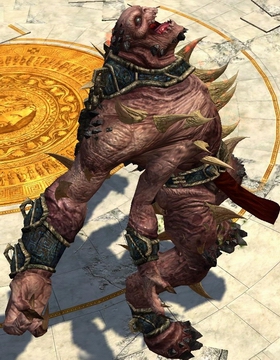Typhon
(ancient Greek: Τυφων, Tuphōn), also Typheus/Typhoeus
(Τυφωεύς, Tuphōeus), Typhaon (Τυφάων,
Tuphaōn) or Typhos (Τυφώς, Tuphōs) is the
final son of Gaia, fathered by Tartarus, and is the most deadly monster of
Greek mythology. Typhon attempts to destroy Zeus at the will of Gaia,
because Zeus had imprisoned the Titans. Typhon was described in pseudo-Apollodorus,
Bibliotheke, as one of the largest and most fearsome of all creatures. His
human upper half reached as high as the stars. His hands reached east and
west and had a hundred dragon heads on each. His bottom half was gigantic
viper coils that could reach the top of his head when stretched out and made
a hissing noise. His whole body was covered in wings, and fire flashed from
his eyes. He was defeated by Zeus, who trapped Typhon underneath Mount Etna.
Hesiod
narrates Typhon’s birth:
But
when Zeus had driven the Titans from Olympus,
mother
Earth bare her youngest child Typhoeus of the love of
Tartarus,
by the aid of golden Aphrodite.
In
the alternative account of the origin of Typhon (Typhoeus), the Homeric Hymn
to Apollo makes the monster Typhaon at Delphi a son of archaic Hera in her
Minoan form, produced out of herself, like a monstrous version of Hephaestus,
and whelped in a cave in Cilicia and confined there in the enigmatic Arima,
or land of the Arimoi, en Arimois. It was in Cilicia that Zeus battled with
the ancient monster and overcame him, in a more complicated story: It was
not an easy battle, and Typhon temporarily overcame Zeus, cut the
“sinews” from him and left him in the “leather sack”, the korukos
that is the etymological origin of the korukion andron, the Korykian or
Corycian Cave in which Zeus suffers temporary eclipse as if in the Land of
the Dead. The region of Cilicia in southeastern Anatolia had many
opportunities for coastal Hellenes’ connection with the Hittites to the
north. From its first reappearance, the Hittite myth of Illuyankas has been
seen as a prototype of the battle of Zeus and Typhon.
Typhon
was the last child of Gaia. He was rejected by all, even his brothers, the
Titans, due to his monstrous appearance. Typhon began to plot his revenge
when he met Echidna.

Typhon
fathered several children, including Cerberus.
The
Sphinx was sent to keep people from exiting Thebes. She was the most
brilliant of Typhon’s children, and set up traps along the road to Thebes.
She would recite her riddle to anyone who got past them. Oedipus eventually
killed the Sphinx. Typhon then sent a human servant to reveal his parentage,
driving him insane.
The
Nemean Lion was a brute with impenetrable skin. Selena adored the beast, and
protected him from harm. When Zeus distracted her, Heracles killed the lion.
He took its fur for armor. Typhon began to prepare his siege on Olympus
around this time.
The
Hydra terrorized the island villages of Greece. When Heracles killed her,
Typhon openly declared war on the Gods.
Around
this time, Typhon’s last child, Chimera came of age. Chimera was
completely unstoppable until Bellerophon with Pegasus killed her.
Typhon
started destroying cities and hurling mountains in a fit of rage. All of the
gods of Olympus fled to their home. Only Zeus stood firm, and the battle
raged, ending when Zeus threw Mount Etna on top of Typhon, trapping him.
The
inveterate enemy of the Olympian gods is described in detail by Hesiod as a
vast grisly monster with a hundred serpent heads “with dark flickering
tongues” flashing fire from their eyes and a din of voices and a hundred
serpents legs, a feature shared by many primal monsters of Greek myth that
extend in serpentine or scaly coils from the waist down. The titanic
struggle created earthquakes and tsunamis. Once conquered by Zeus’
thunderbolts, Typhon was cast into Tartarus, the common destiny of many such
archaic adversaries, or he was confined beneath Mount Aetna, where “his
bed scratches and goads the whole length of his back stretched out against
it,” or in other volcanic regions, where he is the cause of eruptions.
Typhon
is thus the chthonic figuration of volcanic forces, as Hephaestus (Roman
Vulcan) is their “civilized” Olympian manifestation. Amongst his
children by Echidna are Cerberus, the serpent-like Lernaean Hydra, the
Chimera, the hundred-headed dragon Ladon, the half-woman half-lion Sphinx,
the two-headed wolf Orthrus, and the Nemean Lion.
Typhon is also the father of hot dangerous storm winds, which issue forth from the stormy pit of Tartarus, according to Hesiod.